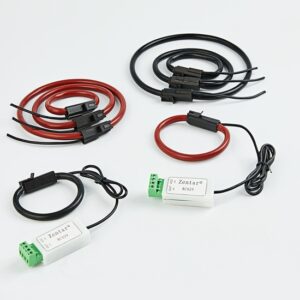You should be clear about the scope of inductance in the power circuit. Since the inductance is mostly not stable during the entire working period of the components, it is particularly important to grasp the scope of the effective value. For inductors used in power switching applications, the overall goal of allowable harmonic distortion current and transient response will determine the inductance requirements. Generally, the harmonic distortion current is maintained at 30% or more moderately of the load output current. If the inductor is used in filtering applications, its characteristic impedance must be sufficiently high to attenuate the overall target noise frequency. Technical engineers can rely on online design tools and formula calculations to calculate the appropriate inductance value. The inductance generally changes due to the released DC current, temperature, or communication pulse signal from the AC drive. In order to ensure that the inductance is maintained within the overall target range, these are all factors that must be considered.
inductance
The rated value saturation current value refers to the amount of DC current that the inductor can apply to before the reasonable inductance value of the inductor is reduced to a certain percentage from the allowable error value. The saturation state current of the inductor released by the manufacturer is very easy to cause misunderstanding. Different manufacturers will set the reduction percentage to 20% or 30%. In product introductions, trend graphs are generally used to show the transition of the inductance value relative to the DC current. The figure is more infectious than the data published by the manufacturer, because it shows the transformation of the inductance in the range of a large load current, rather than just limited to the bursts listed in the product introduction.
The distributor of the output power inductor shows the rated heating current, but like the saturation current, this main parameter is also likely to cause misunderstanding. This main parameter means the DC current required to increase the inductor temperature by an amount specified by the dealer (generally 40°C). The prerequisite for obtaining this rated current in the product introduction is to select a special detection setting that allows a relatively high heat value derived from the sensor according to the wiring terminal. Therefore, the rated current may only be used as a natural number for predicting and analyzing the temperature rise of the inductor. Passive or active cooling mode, total PCB wiring width, total gas flow rate and closeness to other components are likely to cause the specific temperature of the inductor to be very different from the temperature implied by the rated thermal current. same. In addition, for the application of high harmonic distortion amplitude, the communication loss caused by the transformer core and winding will also cause the temperature to rise. In fact, if the inductor is abnormally increased in temperature under a special load current, the design staff will most likely have to verify whether there is sufficient heat generated by the terminal and activated carbon fiber, or the power circuit is not in operation. The inductor causes too much communication loss.
Higher rated heating current matches higher efficiency and lower operating temperature. This type of assumption is established under general conditions, but it is not always appropriate. Although large inductors generally have lower AC power loss and higher efficiency, their heat rejection is usually worse. For two inductors with the same specifications and inductance, the flatter inductor will have stronger natural cooling characteristics, allowing it to maintain a lower operating temperature of 5˚C to 10˚C, even if it generates a little heat. Except for more. Compared with the ferrite core, the molded inductor has excellent cooling characteristics, and can show more reasonable heat convection on the surface of the inductor with its excellent heat transfer. Although the rated heating current may be valid data information, it lacks the content of communication loss information that may be particularly important for the design of moderate thermal characteristics.
Because there will not be an ideal inductor, the physical model of the inductor closed circuit is connected in series with the resistance measurement after communicating the AC resistor, inductance, and capacitance in parallel. Under self-series resonance (SRF), inductance and parasitic capacitance produce a series resonant power supply circuit. At this time, the series communication AC resistor (R) becomes the core component. SRF is also the larger characteristic impedance (Z) point of the inductor. After the SFR frequency is exceeded, the capacitor is the core component, so the component will no longer work like an inductor. For filtering applications, as long as the characteristic impedance is sufficiently manipulated by the resistor, an inductor beyond the SRF can be used to moderately attenuate the overall target frequency. As everyone knows, in the DC/DC converter application of energy storage technology, in order to better prevent the occurrence of devastating current peaks and resonance, the output power of the inductor cannot be higher than the inductor frequency that gradually rises due to SRF.
Today’s electronic circuits have increasingly stringent electromagnetic compatibility testability (EMC) and interference signal (EMI) regulations. Cables, PCB board wiring and other microwave sensors or digital power amplifier components will transmit noise or radiation sources to the surrounding environment. Inductors are not excepted. If the shielding is not good enough, the inductance electromagnetic coil will produce magnetic coupling, causing transmission noise in the PCB wiring and surrounding components. The electromagnetic coil can even be used as a weak wireless antenna to radiate EMI to remote power circuits and peripheral equipment. The ferrite core is particularly noisy because the edge magnetic flux at the magnetic density does not continue. In comparison, composite inductors show stronger electromagnetic shielding, not only because the magnetic density of the distributed system is conducive to greatly reducing the edge magnetic flux, but also because the metal material particles with high magnetic permeability completely encapsulate the electromagnetic coil , Has a reasonable suppression effect on the electromagnetic field.
There are many independent innovative solutions for the application of different types of magnetic tapes on the sales market. Compared with the use of discrete inductors from several companies, this type of packaging method can show advantages in indoor space and cost savings and improve characteristics. For example, in order to better save PCB indoor space, Vishay’s IHLD series products encapsulate two inductors in one product. This type of design is particularly suitable for Class D audio amplifiers. VishayIHCL also encapsulates two high-aspect-ratio coupled inductors in one product for use in SEPICDC/DC converters and common mode applications. Figure 3 shows this solution.
summary
The output power inductor is an indispensable energy storage technology component, which can make the filter and the circuit work normally. The design staff must select an inductor that can show better characteristics with fewer specifications at an affordable price. This must carefully consider the following basic inductor characteristics: inductance, DCR, contrast, rated thermal current, characteristic impedance, SRF, high efficiency, thermal characteristics, specifications, and noise transmission.




